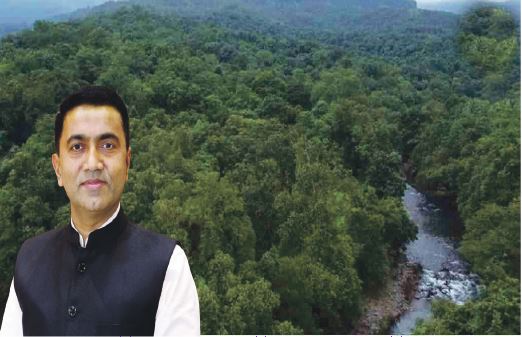Goa is abuzz with excitement as vintage bike and car owners, users, collectors and fans are decking […]

CM WANTS TO KILL FORESTS…
Cover Story, June 29- July 05 2024 June 28, 2024To promote mining and polluting industries!
By Rajan Narayan
IN what may spell the death of whatever remains of Green Goa, Chief Minister Dr Pramod Sawant wants 36 villages dropped from the list of 99 eco-sensitive zones. The state government has written to the Union Environmental Ministry admitting that the villages that were dropped have major and minor mineral deposits. Chief Minister Dr Sawant makes this incredible statement that while forests can be moved from one place to another, natural resources and industries should not be touched.
This is the first time any chief minister of any state in the country has admitted that he wants to destroy forests for the benefit of iron ore mines and polluting industrial units. Clearly, the chief minister wants to aggressively promote the revival of iron ore mining in the state. The chief minister seems to be determined to ensure that there are no obstacles to the revival of mining. The minor minerals he is referring to are the extensive sand mining of the river beds and beaches of Goa.
The state government also wants sand mining to be permitted on the sand dunes of beaches. The destruction of sand dunes is a major cause of massive sea erosion on various beaches of Goa. Similarly, the extraction of large amounts of river sand for the construction industry has been and is twisting the rivers out of shape and squeezing their ecology and killing them finally.
The Pramod Sawant-led BJP government also wants to protect the highly polluting industrial units that have come up in Goa starting with Zuari industries. Many major multinational corporations like Hindustan Lever and Nestle have manufacturing units in the state. Among the most polluting units is Deccan Chemicals which took over the Syngenta pesticide unit in Corlim and Old Goa.
POLLUTING INDUSTRIES
IRONICALLY, the Deccan Chemical plan is called the Santa Monica factory. This is because the land was owned by the historical Santa Monica Convent and sold by the bishop to the promoters of the polluting chemical and pesticide unit. The lowering of eco-standards is to help the Adani Group of companies to take over whatever they can of the Goa (along with the Deltin Group which has major stakes in turning Goa into the Las Vegas of India). With regard to the Adani Group it is allegedly to permit the group to import larger quantities of coal from its concession in Australia through the Mormugoa Port. The polluting coal is transported by trucks which are not even covered properly to the Jindal Steel unit in Hospet.
The South Central Railway has started double-tracking the railway line to increase the coal-carrying capacity of the railway carriages. The double-tracking affects the villages of Majorda and Carvelossim and destroyed paddy fields and ancestral homes in south Goa. There have been huge ongoing protests against the double-tracking which goes through the villages of south Goa. When mining in Goa resumes to its original levels iron ore will also be transported by barges and trucks to the port for export.
The villages of Goa are unique in that they still retain extensive tree cover. Many of the village roads have coconut trees planted on either side as in Parra, the home village of the late chief minister of Goa Manohar Parrikar. Most villages have a canopy of trees or several of forested areas yielding a gamut of useful local produce.
VILLAGE ABUNDANCE
LIKE for instance the village of Canacona which is famous for some of the hottest chilli peppers (khola) in the world. There are villages which produce an abundance of the popular fragrant flowers of Goa called zaiyo. Goa is full of mango, coconut, cashew nut orchards. The encroached and dying lands of the kulgar (tribal people) produce pepper and cardamom and other spices in large quantities. Goa has large coconut groves which cannot be fully tapped due to a shortage of coconut tree labor to climb and harvest the coconuts and other residual produce.
Currently, it is the jackfruit season and the markets are flooded with raw and ripe jackfruits. Unfortunately, many jackfruits on trees are not harvested and they rot on the trees or fall to the ground and nobody wants the heavyweight fruits because dealing with them requires some hard work. They are free for takers.
Goa is the only state in the country which has a village and semi-urban ambience sporting lanes with trees lining them on both sides with innumerable water bodies making for cultivated fields and many wells. This is so even with arterial roads in Goa, one of the charms of Goa. Take for example, the Dayanand Bandodkar main road or Campal promenade of capital city Panjim. The Dona Paula to Miramar and on to ferry wharf main thoroughfare is lined with old world trees and lovely enclave of villas in prime urban town Panjim. Even in the crowded St Inez road vicinity has centuries old banyan and peepal trees and one of which had to be rescued and planted to the Campal promenade grounds, to facilitate new roadways services.
PERHAPS Chief Minister Dr Pramod Sawant doesn’t seem to understand that the forest accounts of 60.62% of the total land area of Goa. There are many parts of Goa which are classified as private forests in addition to the government forests and existing government planning rules to do with forest areas cannot be tampered with. Indeed, even to cut down a single tree, you need permission from the Forest department.
CLIMATE IMPACT
THE change in climate in Goa has just witnessed heat waves in the summer gone by and this is undoubtedly a warning to what happens when ruthless cutting down of entire plateaus, hill slopes and forested areas are cut down for urban progress and development. Large tracts of forested lands in Bicholim, Quepem, Curchorem, Sanvordem, etc, are lost. Mining is even being carried out within notified wildlife sanctuaries in the state.
The 20 years of mining ban has permitted all the destroyed agricultural fields of the country rural people to return to Goa. This will be under threat anew because of the signal for revival of mining. The Pollution Control Board has already strongly protested against the legal and illegal mining of sand for the booming construction industry in Goa. Real estate developers who are making a beeline to Goa require large amounts of sand in developing their townships here, there and everywhere. Sand is mixed with cement in the mixture which goes towards constructing monster multi-storied buildings even in hitherto much loved quiet villages like Siolim and Saligao.
Indeed, Assagao was once considered the village of flowers but today it has become or is becoming rapidly into a concrete jungle. The less said about Goa’s coastal villages, the better. All the coastal villages from Calangute, Baga, Morjim and Arambol have become coastal garbage filled slums. Similarly, coastal villages down south Goa like Majorda, Betalbatim, Colva and Benaulim have become more urban than rural.
GOA’S CHARM
THE CM does not realize that it is the villages of Goa which make Goa unique in character and personality. More than the beaches, it’s the green villages which their ancestral and more modern homes which are major tourist attractions of Goa. This is why all the bold and beautiful from Sachin Tendulkar to the former MDTV boss Pranoy Roy have invested in village second homes for themselves in Goa. We understand that the latest celebrity to re-cate in Goa is noted election strategist Prashant Kishor.
The ground reality is that Goa and Goans do not need or want highly polluting industries. It’s a tiny hilly and coastal, riverine state with its villages, townships and so called cities mostly on par with sea level; it does not want the Mormugoa port to be used for gaguantan import of coal from Australia or anywhere else. The imported coal does not benefit Goans in any way. There are no industrial units in Goa which require coal.
Similarly, all the iron ore mined in Goa is exported to Japan and Korea. The mining units in Goa are no longer even owned by Goan industrialists. Since the mining leases went up for auction it is now the Mittal of UK and the Jindal groups who have taken over the mining leases in Goa.
Goans do not want mining of sand from their rivers for the benefit of the runaway and uncontrolled construction industry. There are already too many buildings in Goa and Goa does not have the infrastructure to cater to additional rich migrants from Delhi, Mumbai and Bengaluru. Goa already has a lot of polluting industries that emit toxic gases into the air and curse the people with respiratory ailments.
The Cuncolim industrial estate has a large number of polluting units. Goa has not been interested in promoting IT units which would be ideal for Goa. Goa is unlikely to catch the AI superfast train.
SHIFT CHIEF MINISTER
ALL Goans should come together to tell the chief minister that forests cannot be moved, it’s a laughable thought. Forests take centuries to come up. They are not cars which can moved just because the chief minister wants to move them. On the other hand, Goa can certainly say no to the revival of the iron ore industry. It can stop illegal removal of sand from river beds and sea shores. It can stop the encroachment and takeover of mangroves. It can stop the import of coal through MPT. It can stop the transportation of extremely polluting coal through the villages of Goa. Perhaps it is time Goans told Chief Minister Dr Pramod Sawant that it is easier to shift the chief minister than to shift the forests out of Goa.















